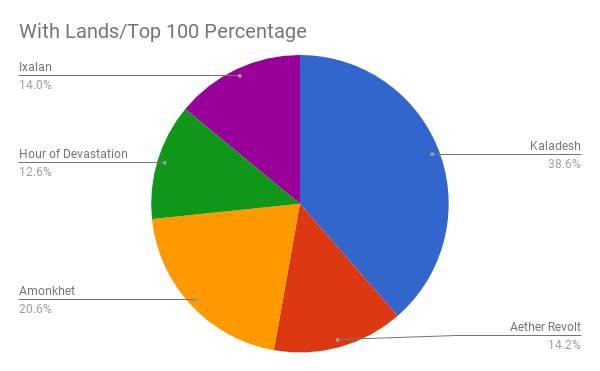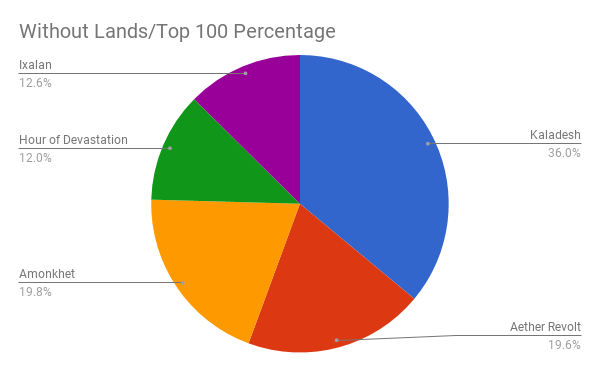With Grand Prix Santa Clara in the books, the final event of the Ixalan Season is now behind us. Before we dive into the Rivals of Ixalan pre-release events this weekend, let’s take some time to reflect on the impact Ixalan had over the 111 days between the release of Ixalan (September 30th) and the upcoming release of Rivals of Ixalan (January 19th).
Across those 3.5 months there were 21 National Championships, 15 Grand Prix events, one Pro Tour, one World Magic Cup, and one World Championship. Thanks to the timing of annual events, the fall expansion often has an opportunity to shine brightly at the highest competitive tables of the greatest card game in the world. So how did Ixalan do under that spotlight?
Standard
Nine top-level events this season featured the Standard constructed format, though you could easily consider that number to be 29 if you count each of the October 14th national championship events as an independent entity. Nonetheless, the story of the past three months of Standard has very much been the same as the preceding months of Standard: energy, energy, energy.

This chart is drawn from data provided by mtgtop8.com by reviewing the top 100 cards played in Ixalan Standard events (which includes events beyond the major events listed above). Including lands, we can see that Kaladesh far and away has domination of the Standard format. This is largely thanks to the dominance of various energy decks which all run Aether Hub (60.4% of decks) and Attune with Aether (46.5% of decks).
We can see that Amonkhet also has a significant chunk of the pie and that Ixalan is no slouch either. Even though Kaladesh has clear control of the format, the other five expansions are somewhat evenly represented. Abrade, Glorybringer, and The Scarab God all help Amonkhet and Hour of Devastation carve out their niche in the format, aided further down the list by cards related to the God-Pharoah’s Gift decks.

But, if we take lands out of the equation things shift ever so slightly and a different picture emerges. Kaladesh is still the dominant set but Aether Revolt and Amonkhet are now clear “Tier 2” sets while Hour of Devastation and Ixalan are “Tier 3.” This change highlights a very simple fact which is that Ixalan’s key role in Standard right now is to provide access to the ally-colored cycle of dual lands, especially Rootbound Crag (32.5% of decks).
There are a few non-land cards from Ixalan that have made a splash in Standard including Search for Azcanta (17.8% of decks) and Vraska’s Contempt (17.6% of decks) but these are mostly added to existing decks from the meta-game. There is no format-defining deck from Ixalan. No Pirates deck nor Dinosaur deck that’s able to establish a foothold against the existing dominant strategies of the energy and vehicle decks of Kaladesh and Aether Revolt nor the burn and control decks of Amonkhet and Hour of Devastation.
Did Ixalan fail to make an impact because it isn’t a strong enough set or is it because Kaladesh is simply too powerful? The numbers imply that Kaladesh is simply too powerful, as it stands head-and-shoulders above every other Standard-legal expansion, including another large expansion in Amonkhet. Ixalan is certainly a bit weak and on-par with Hour of Devastation, but it isn’t so far below the curve that is should be so underrepresented.
Limited
There were a total of eight Grand Prix events for Ixalan limited and I think that looking at the attendance trend of these events should give us a pretty good idea of how popular Ixalan limited turned out to be. We’ll want to look at two things: how attendance trended from the start to the end of the season, and how it compared to Kaladesh limited last fall.
- September 30th – GP Shizuoka (557 Teams) / Providence (562 Teams)
- October 28th – GP Hong Kong (727) / Liverpool (1209) / Phoenix (1114)
- November 25th – GP Lyon (628 Teams)
- December 16th – GP Singapore (574) / New Jersey (1133)
Those are pretty consistent attendance numbers, especially tracking the North American metrics from Providence to Phoenix to New Jersey. It’s interesting to note that Shizuoka had 557 teams, well over 1500 players, while Hong Kong and Singapore had a half and a third of that total respectively. This is likely more about the popularity of the team format in Japan versus the individual format in the wider Asia Pacific.
So how does that compare to some Kaladesh events from a year ago?
- October 8th – GP London (2566) / Atlanta (1663)
- November 12th – GP Rotterdam (701 Teams)
- December 10th – Milwaukee (1326)
It’s safe to say that Ixalan limited Grand Prix attendance was down from Kaladesh limited Grand Prix attendance and that should be somewhat concerning. It’s possible that having more Grand Prix events meant fewer people attended each event. However, this is likely more of a case of timing for the season rather than the overall growth of the GP schedule.
Ixalan limited wasn’t bad, per se, but it wasn’t as enticing as Kaladesh limited was last fall. The numbers didn’t drop off by a huge amount, but certainly by a noticeable amount, especially if you compare Atlanta’s 1600 players to Phoenix’s 1100 and Milwaukee’s 1300 to New Jersey’s 1100. It’s a trend that Wizards of the Coast and Channel Fireball will need to put a stop to if they want to grow the game’s competitive circuit.
Modern
It’s a bit surprising that with a Modern Pro Tour coming up for Rivals of Ixalan, we’ve only seen three major events in the past three months feature the format. Not only that, but two of the events were team events of one form or another. So what’s Modern even like these days and is Ixalan going to make an impact there?
Search for Azcanta and Field of Ruin both made some minor appearances in Grand Prix Santa Clara’s top eight decks this past weekend. Field of Ruin is an especially interesting alternative to Ghost Quarter for decks like Vidianto Wijaya’s U/W control deck, that don’t want to fall behind on land count.
However, most of the format’s staple decks like Death’s Shadow, Affinity, Tron, and Storm, had little to gain from Ixalan’s addition to the format. Control as a deck option is fairly dominated by the Lantern Control and Tron archetypes. However, for those who decide to pick up a more traditional UW control deck, definitely grab a few copies of Search for Azcanta.
Legacy
There were two events during Ixalan season that featured Legacy in some format: Eternal Weekend on October 19th and this past weekend’s Grand Prix in Santa Clara, which as mentioned above, was a team trios event. Many people are quick to dismiss the inclusion of Legacy in this kind of wrap-up, given the common sense that new cards will never be powerful enough to compete with such behemoths of the game like Tarmogoyf and Force of Will.
That simply isn’t the case. Looking at the top results from Eternal Weekend’s Legacy Championship you’ll note that the top deck included three copies of Fatal Push in the main deck while the second-place deck included Abrade in the sideboard. Legacy decks are not an homage to Magic of days past, but are a rich tapestry of the full 25 years of Magic’s history.
So, what is Ixalan’s place in that history? It looks like Search for Azcanta is going to be Ixalan’s primary, and possibly only, contribution to the current Legacy metagame (not unlike the Modern metagame). Check out this control deck from a recent paper event for an example of where it’s being put to good use. You can see how quickly the deck puts cards like Brainstorm, Ponder, and of course fetch lands into the graveyard to quickly transform Search for Azcanta into Azcanta, the Sunken Ruin. But, more importantly, the ability to stack the top of the deck each turn provides value alongside cards like Entreat the Angels and Terminus.
While it’s not a complete replacement for Sensei’s Divining Top, Search for Azcanta will certainly continue to find a home in Legacy decks which either want to manipulate the top of the deck or want to be able to maximize card selection. That is to say, control decks will make great use of this Ixalan enchantment for a long time to come.
Rich Stein is a retired Magic player, an amateur content creator, and a Level 2 Social Justice Sorcerer. He hopes to eventually become a professional content creator and a Level 20 dual class Social Justice Sorcerer/Bard but he’s more than content to remain a retired Magic player. You can follow his musings on Twitter @RichStein13.

